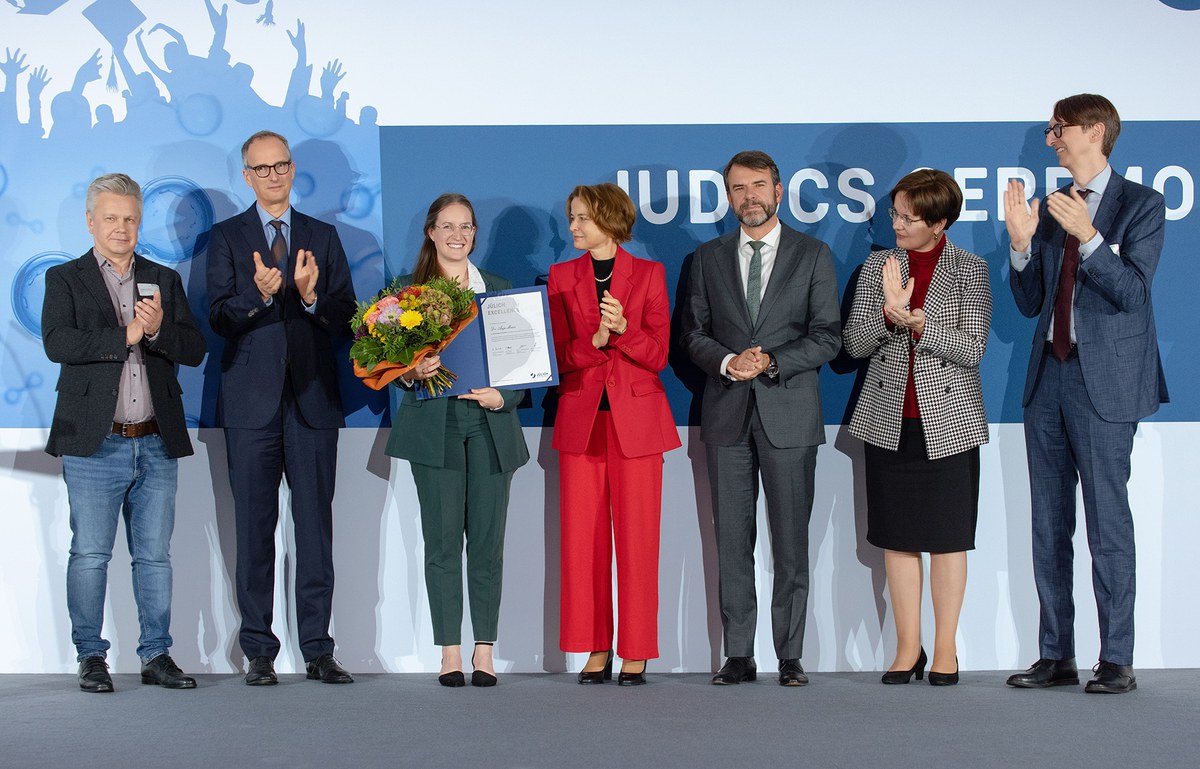Dr. Anja Meier Receives the Excellence Prize for Advancing a Method Analysing Molecules
8 October 2025
Forschungszentrum Jülich has awarded this year’s Excellence Prize to Dr. Anja Meier. In her doctoral work, the chemist played a pivotal role in advancing the field of photoemission orbital tomography (POT). This technology now allows for a much more comprehensive analysis of the chemical properties of molecules and is also more versatile than before. Meier completed her doctoral thesis at the Peter Grünberg Institute for Quantum Nanoscience (PGI-3) at Forschungszentrum Jülich and successfully defended her thesis at the Faculty of Physics in RWTH Aachen University in spring 2024. She now works as a postdoc at PGI-3.

Photoemission orbital tomography – POT, for short – is a method for analysing molecules on surfaces. It can be used to visualize how electrons are distributed in orbitals around the atomic nuclei of the molecule. This allows for a better understanding of the electronic properties and structure of a molecule. In her doctoral thesis, Meier (née Haags) showed that POT can be used in a much wider range of applications than originally assumed. Meier successfully used the method to measure other types of orbitals, applied it to new classes of molecules, and answered a long-standing controversial question about electron distribution in a ring-shaped molecule. These achievements impressed the international selection committee who unanimously chose the chemist as the winner of the Jülich Excellence Prize 2025. “It’s fantastic that I have won,” says the 30-year-old. “I know that several research groups are only just beginning to apply the technique. I hope this recognition will help it attract greater attention and become firmly established.”
The electrons of a molecule are not distributed evenly, but are concentrated in certain areas, the orbitals. To examine these in more detail, POT utilizes the photoelectric effect. This was first explained by Albert Einstein at the beginning of the 20th century. When a light particle, a photon, hits an electron of an atom or a molecule on a metal surface, it transfers its entire energy packet to the electron. If this energy is greater than the binding energy of the electron, it is released from the molecule – it is “photoemitted”, as experts say. The excess energy contributes to the electron’s kinetic energy. By measuring this kinetic energy and the exit angle of the emitted electrons, “momentum maps” can be created. These are compared with theoretical predictions in POT. In this way, individual orbitals of the molecules can be visualized and identified on the basis of their very specific fingerprint in the momentum maps.
Copyright: Forschungszentrum Jülich / Jenö Gellink
In practice, a surface is first coated with the molecules to be analysed, then it is irradiated with UV light, and the emerging electrons are measured. Until now, however, the experimental equipment had its limitations, which is why not all photoelectrons were captured. With the world’s only electron detector of its kind, the ‘toroidal analyzer’ , which is operated by us at the Physikalisch-Technische Bundesanstalt in Berlin, it is possible to measure all photoelectrons emitted above the surface and their energy,” explains Meier. “In this way, we analysed the distribution of the electrons and inferred the true spatial distribution of the orbitals.” According to Meier, this shows that the calculated locations of the electrons are not just a mathematical construct, but are actually real.

An important result of her work was that the method can be used to measure not only p orbitals, but also s orbitals. The two types of molecular orbitals differ in the distribution of electron density and binding energy. In addition, POT can also be applied to non-planar molecules – i.e. molecules where the atoms are not all in the same plane. “Previously, it was not clear how effective POT would be in these cases,” says Dr. Anja Meier. The analysis results for a ring-shaped hydrocarbon molecule, an aromatic called Kekulen, were also groundbreaking. The data on the electron structure obtained by Meier show which theoretical model best describes a certain property of this molecule – its long-contested aromaticity.
The prize committee praised how Meier’s work addressed fundamental scientific questions and thus opened up new perspectives for the identification of molecules on surfaces and for the analysis of chemical reactions at the molecular level. Furthermore, she applied technological methods far beyond their established field of application. “Excellent research comes from excellent minds. We are proud to be able to offer such a talented scientist the right environment for her groundbreaking invention. I am delighted that she will continue her research in Jülich as a postdoc,” said Prof. Astrid Lambrecht, Chair of the Board of Directors at Forschungszentrum Jülich, who is also chair of the selection committee.
Since 2009, Forschungszentrum Jülich has awarded the Excellence Prize for outstanding scientific achievements in early career phases. The prize recognizes researchers whose doctoral and subsequent work has made a significant contribution to scientific progress at Forschungszentrum Jülich. The nominations are evaluated by an international committee consisting of the Chair of the Board of Directors, members of the Scientific Advisory Council (SAC), and the chair of the Scientific and Technical Council (WTR). The decision is based on the originality and innovative value of the research, its international visibility, and how convincingly the candidates present themselves and their work. Anja Meier brings the number of prize winners to 43.
Publications (selection)
Contact
Dr. Anja Meier
Scientific Coordinator at Peter Grünberg Institute (PGI-3)
- Peter Grünberg Institute (PGI)
- Quantum Nanoscience (PGI-3)
Room 326


